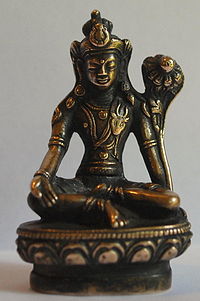Khasarpani: Difference between revisions
Jump to navigation
Jump to search
mNo edit summary |
mNo edit summary |
||
| Line 1: | Line 1: | ||
[[Image:Avalokitestvara Khasarpani.JPG|thumb|200px|Avalokitesvara Khasarpani, 17th century bronze, Tibet; 6.75cm]] | [[Image:Avalokitestvara Khasarpani.JPG|thumb|200px|Avalokitesvara Khasarpani, 17th century bronze, Tibet; 6.75cm]] | ||
'''Khasarpani''' ([[Wyl.]] ''kha sar p'a Ni'')--A form of [[Avalokiteshvara]] with one face and two hands. His right hand is in the [[mudra of supreme generosity]], and the left in the [[mudra of teaching the Dharma]] and holds a lotus blooming at the level of his left ear. Iconographically, Avalokiteshvara Khasarpani is indistinguishable from the seated form of the meditational deity called [[Amoghapasha]] (Unfailing Lasso), and are often conflated in texts | '''Khasarpani''' ([[Wyl.]] ''kha sar p'a Ni'')--A form of [[Avalokiteshvara]] with one face and two hands. His right hand is in the [[mudra of supreme generosity]], and the left in the [[mudra of teaching the Dharma]] and holds a lotus blooming at the level of his left ear. Iconographically, Avalokiteshvara Khasarpani is indistinguishable from the seated form of the meditational deity called [[Amoghapasha]] (Unfailing Lasso), and are often conflated in both Sanskrit and Tibetan texts and practices. | ||
[[Category: Buddhas and Deities]] | [[Category: Buddhas and Deities]] | ||
[[Category: Bodhisattvas]] | [[Category: Bodhisattvas]] | ||
Revision as of 03:16, 5 October 2011

Khasarpani (Wyl. kha sar p'a Ni)--A form of Avalokiteshvara with one face and two hands. His right hand is in the mudra of supreme generosity, and the left in the mudra of teaching the Dharma and holds a lotus blooming at the level of his left ear. Iconographically, Avalokiteshvara Khasarpani is indistinguishable from the seated form of the meditational deity called Amoghapasha (Unfailing Lasso), and are often conflated in both Sanskrit and Tibetan texts and practices.